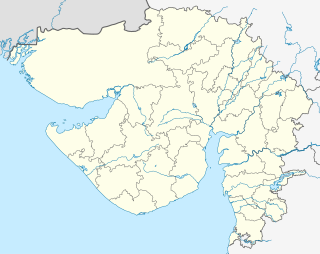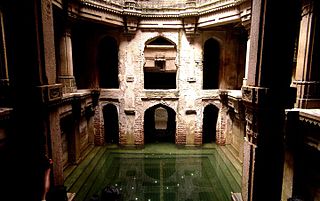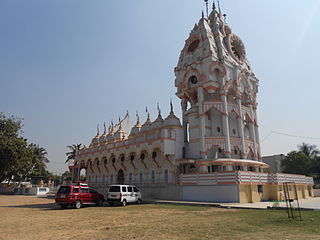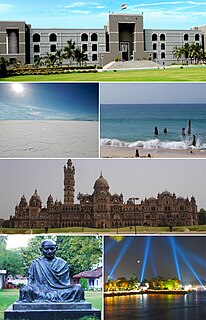
Mehsana, also spelled Mahesana, is a city and municipality in Mehsana district, in the Indian state of Gujarat.
Vikram Samvat ; Listen (help·info)) is the historical Hindu calendar from the Indian subcontinent and the official calendar of modern-day India and Nepal. It uses lunar months and solar sidereal years.

Palanpur is a city and a municipality of Banaskantha district in the Indian state of Gujarat. Palanpur is the administrative headquarters of the district.

Santram Mandir is a temple situated in Nadiad, Gujarat, India run by the Santram Maharaj organization which draws from a Hindu religious figure in Gujarat. The Santram mandir runs trusts for humanitarian activities like Eye Hospital, Physiotherapy Center, Dispensary, Radiology Center, Pathology & Laboratory as well as various other services which is countless. It also carries out various cultural as well as social activities. There are other "Santram Mandir" located in Vadodara, Karamsad, Padra, Koyli, Umreth, Radhu, Kalser, Pachegaam, Chaklasi, Sojitra & Varad. And several other places has its Paaduka like Raniya, Narsanda, Sarsavni, Salun, Piplag, Alindra and many more places.

Mehsana district is one of the 33 districts of Gujarat state in western India. Mehsana city is the administrative headquarters of this district. The district has a population of over 1.8 million and an area of over 4,500 km². There are over 600 villages in this district with a population of 1,837,892 of which 22.40% were urban as of 2001.

Khedbrahma is a town and a taluka headquarter in Khedbrahma Taluka of Sabarkantha district, Gujarat, India. It is situated on the banks of Harnav river. The town is connected with mythological history and has been pilgrim site for centuries. The 11th century Brahma, Ambika and Pankhnath Mahadev temples are the oldest monuments of the town. The town has two old stepwells, the Brahma stepwell and the Aditi stepwell. It was under Parmaras, Chaulukyas and Pariharas before it came under Idar State in 13th century.

Mansa is a town with municipality and former princely state, in Gandhinagar district in the western Indian state of Gujarat.

Sathamba is a town located in Aravali district of the Indian state of Gujarat and the seat of a former petty Koli princely state. It has a population of approximately 15,000.
Bagda is a village near Bhadresar in Kutch district, Gujarat, India.

Adalaj Stepwell or Rudabai Stepwell is a stepwell located in the village of Adalaj, close to Ahmedabad city and in Gandhinagar district in the Indian state of Gujarat. It was built in 1498 in the memory of Rana Veer Singh, by his wife Queen Rudadevi. It is a fine example of Indian architecture work.
Modhera is a town in Mehsana district of Gujarat, India. The town is well known for the Sun Temple of Chaulukya era. The town is located on the bank of river Pushpavati.

Bhadresar or Bhadreshwar is a village in Mundra Taluka, Kutch district of Gujarat, India. It is about 27 km from Taluka headquarters Mundra and barely a kilometer away from the seashore.

Amritavarshini Vav, also known as Panchkuva Stepwell or Katkhuni Vav, is a stepwell near the Panchkuva Darwaja in Ahmedabad, Gujarat, India.
The Chudasama dynasty ruled parts of the present-day Saurashtra region of Gujarat state in India between the 9th and 15th centuries. Their capital was based in Junagadh and Vamanasthali, and they were later classified among the Rajput clans.
Stepwells are wells in which the water is reached by steps. They are most commonly found in western India especially Gujarat where over 120 such wells are reported. The origin of the stepwell may be traced to reservoirs of the cities of the Indus Valley Civilization such as Dholavira and Mohenjo-daro. The stepwells were constructed in the south western region of Gujarat around 600 AD. From there they spread north to Rajasthan and subsequently to north and west India. Construction activities accelerated during the 10th to 13th century during the Chaulukya and Vaghela periods. The construction of these stepwells hit its peak during the 11th to 16th century. The Muslim rulers of the 13th to 16th century did not disrupt the culture that was practiced in these stepwells and encouraged the building of stepwells. The wells lost their significance in the 19th century due to introduction of water pumps and pipe-systems.

Madhavav or Madhav Vav is a stepwell located in Wadhwan town of Surendranagar district, Gujarat, India. It is located in the western side of old town.

Mithi Vav is a stepwell located in Palanpur town of Banaskantha district, Gujarat, India. It is considered the only surviving monument of Parmara rule in the town. It was built around the 8th century. It is situated in the eastern part of the town. The five storey stepwell can be entered from the west. Based on its architectural style, it is believed that it is constructed in late medieval period but the sculptures embedded in the walls may belong to earlier period. The sculptures include that of Ganesha, Shiva, Apsaras, dancing figures, worshiping couples and floral or geometrical patterns. A worn out inscription found on one sculpture embedded in left wall cannot be read clearly, but the year Samvat 1320 can made out.

The Khed-Roda Group of Monuments include 8th-9th century dated seven Hindu temples built during Gurjara-Pratihara or Rashtrakuta period. It also include a reservoir (Kund) and a stepwell. They are located between Raisingpura (Roda) and Khed Chandarani villages, 18 km from Himmatnagar in Sabarkantha district of Gujarat, India. It is located on the bank of the seasonal stream which merges Hathmati river downstream.

Ra Khengar Vav or Ra Khengar stepwell is a 13th-century stepwell located near Koyliphatak village between Vanthali and Junagadh in Gujarat, India.














